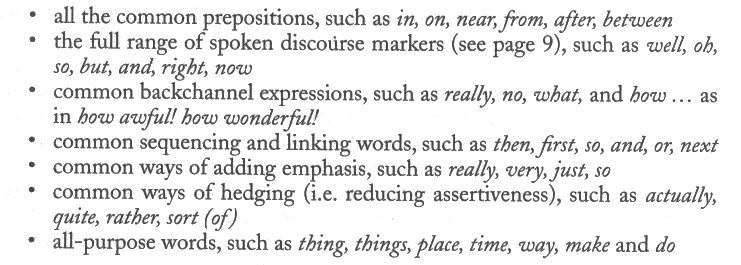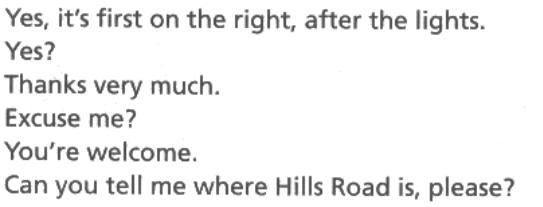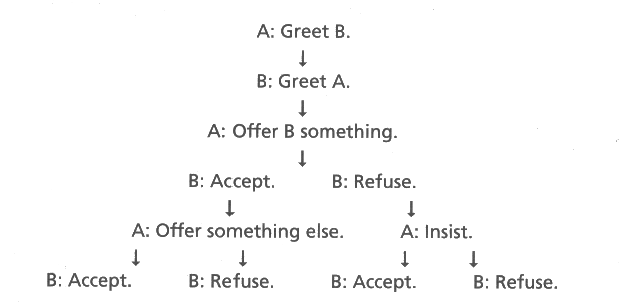
Teaching speaking: communicative approach
Speaking mechanisms
Research (and the common sense) suggests that there is a lot more to speaking than the ability to form grammatically correct sentences and then to pronounce them. It typically takes place in real time, with little time for detailed planning.
What mechanisms allow us to speak?
Spoken fluency requires the capacity to arrange a store of memorised lexical chunks.
Moreover, since the grammar of spoken language differs from the grammar of written language, the study of written grammar may not be the most efficient preparation for speaking.
Speaking is a skill and as such it needs to be developed independently.
In order to achieve any degree of fluency, some degree of automaticity is necessary. Automaticity allows speakers to focus their attention on the aspect of the speaking task that immediately requires it, whether t is planning or articulation.
Automaticity is partly achieved through the use of prefabricated chunks.
In this sense speaking is like any other skill such as driving or playing a musical instrument: the more practice you get, the more likely it is you will be able to chunk small units into larger ones.
Speaking skills require more than just that:
Turn taking: speakers should take turns to hold the floor
The skills by means of which it becomes possible are as follows:
recognising the appropriate moment to get a turn - signalling the fact that you want to speak
holding the floor while you have your turn
recognising when other speakers are signalling their wish to speak
yielding the turn
signalling the fact that you are listening
Different types of speech events
Service encounters, such as buying goods, getting information, or requesting a service, are transactional speech events that follow a predictable script. Typically, the exchange begins with a greeting, followed by an offer, followed by a request and so on:
- Good morning
- Good morning
- What would you like?
- A dozen eggs, please.
- Anything else?
An important factor that determines the character of a speech event is whether it is interactive or non-interactive. A casual conversation between friends is a typical example of an interactive speech event. Monologues such as a television journalist’s live report or a university lecture are non-interactive.
A distinctions is also to be made between planned and unplanned speech. Certain speech genres such as public speeches and business presentations are typically planned, to the point that they might be completely scripted in advance. A phone conversation to ask about timetable information, while following a predictable sequence, is normally not planned in advance.
Discourse markers
Researchers of transcribed speech have demonstrated that the 50 most frequent words in spoken English make up nearly 50% of all talk.
The word well occurs about nine times more often in speech than in writing!!!
Well is an example of a discourse marker which is very common in interaction. Spoken language also has a high proportion of words and expressions that express the speaker’s attitude to what is being said: probably, maybe, really, actually etc.
Chunks
Speakers achieve fluency through the use of prefabricated chunks: These are sequences of speech that are not assembled word by word but have been preassembled through repeated use and are now retrievable as single units.
Chunks are also known as lexical phrases, holophrases, formulaic language and prefabs. Of the different types of chunks the following are the most common: collocations: densely populated, set the table
phrasal verbs: run out of, go on about
idioms, catchphrases and sayings: make ends meet, as cool as a cucumber
sentence frames: what really puzzles me is…
social formulas: have a nice day, mind your head
discourse markers: if you ask me, by the way
Vocabulary
Native speakers employ over 2,500 words to cover 95% of their communicative needs. Learners can probably get by half that number, especially for the purposes of casual conversation.
Even the top 200 most common words will provide the learner with a lot of conversational mileage, since they include:


Using listening as a tool for teaching speaking
Materials:
Authentic and non-authentic recordings
Scripted recording incorporated features of natural speech
Soap operas, documentaries, extracts from the films, radio and TV programmes, game shows
The procedure
Activating background knowledge It may help to establish the topic or the content of the event, brainstorming vocabulary, the teacher can introduce new items
Checking gist Playing the extract and asking general gist questions like: Who is talking to whom about what and why? Repeated listening may be necessary
Checking details
The learners may be set further tasks e.g. a grid to fill, a mutliple choice questions to answer
- Listen and read stage hand out the transcript, replay the recording while the students listen silently - resolving doubts the students are given the opportunity to ask about any doubts or problems they have about the text - focus on language features filling in the gaps exercises, spot the difference exercises
- Focus on speech acts, focus on discourse markers, focus on sociocultiral rules, on features of spoken grammar, on vocabulary, on the use of lexical chunks, stress and intonation
Live listening – listening to the teacher or guest speaker The main advantage is a possibility to adjust the speech and interactive character
The teacher introduced the topic e.g. of his brother by showing a family photograph. Then he told the story using natural but uncomplicated language and occasionally stopped to check understanding (e.g. to explain a term). During the story he used a number of time and sequencing expressions (eventually, all of a sudden, to cut a long story short etc.) At the end of the story the students are invited to ask questions.
Noticing-the-gap-activities
The teacher sets up the context for a speech event – e.g. two people fixing a date to meet or someone returning a faulty item to a shop. 1) Learners are paired off and attempt to perform a task, using the linguistic means they have.
2) Then they listen to the recording – or watch a video – or two experts performing the same task.
Recordings of skilled speakers performing the task are played
Introduce the speakers on the cassette;
Make sure the students realise the speakers are doing a similar task to the one they will do or have done;
Make sure they know that you don’t expect them to understand everything. Tell them it might sound difficult to start with, but you will play several times.
Having listened to the task being performed learners should then have the chance of studying the transcript of the recording. They can be asked to note any features such as useful expressions that they would like to incorporate into their performance.
Variant of the notice-the-gap activity: We allow the learner to perform the task in the L1 and then reformulate it in the target language allowing the student to see the difference.
Minuting the lesson
The learners can be asked to reflect on the lesson and recall anything that they consciously noted.
The students are asked to write down a personal note in the form of “something someone said that surprised me” or “a word or expression I particularly liked” tec.
Controlled practice
Drilling
The notion of practised control need not rule out the value of some mechanical and repetitive activities of the type traditionally associated with drilling.
Drilling – imitating and repeating words, phrases, and even whole utterances
After the students have listened to a taped dialogue they may be asked to repeat some isolated specific phrases or utterances. If all the dialogue were drilled the benefit would be lost!
Drilling may help in the storing and retrieving of the chunks and catchphrases etc.
Milling activities
They involve learners walking around, asking all the other learners questions with a view of completing a survey or finding a close match. For example: Would you ever go hang-gliding? Would you ever eat a snake?
It will involve the repeated asking of the question but in a context that requires some re-allocating some attention away from grammatical processing and on to some mental and physical tasks.
Then the students report to the class the results of the milling activity.
Ask your partner the following questions, take some notes and then report the information about him/her to the class.
When do you usually get up?
Do you do exercises in the morning? Do you go jogging?
Do you usually have a shower?
What do you have for breakfast?
When do you leave home?
How many lessons do you have every day?
Do you have a lot of homework?
When do you come back home?
When do you have dinner? What do you have for dinner?
What do you do in the evening?
Do you read a book or watch TV before you go to bed?
When do you go to bed?
Writing activities
Paper conversations
Learners have the conversations with their classmates but instead of speaking, they write the conversation on a shared sheet of paper.
While the students take part in this small talk, the teacher can make improvements more easily than when students are actually speaking.
Rewriting dialogues
Asking learners to rewrite, improve or modify written dialogues.
Changing the register
Making it more interactive (incorporating comments)
Including positive appraisal language
Adding pause fillers and false starts
Extend the length of the turns
Incorporating discourse markers: so, well, right, oh
Incorporating ellipses: What’s your name? – Juan
Making the talk more idiomatic
Making the talk less direct, using vague language (sort of, kind of)
Dialogues
Chunks on cards – learners work in pairs to have a dialogue, and each has a set of cards with useful expressions on them, such as by the way, speaking of which etc. The idea is to include as many of these features into their conversation as possible adding the card to a discard pile each time it is used. This can be turned into a game – the first person to discard all their cards is the winner.
Ordering a jumbled dialogue

Flow diagram conversations
Learners, in pairs, perform the dialogue, following the route trough the different functions selecting from memory appropriate expressions fro the different speech acts.

Conversation tennis
A: What did you do yesterday?
B: I worked all day. Then I went to the gym.
A: Did you?
B: What did you do?
Set the learners the task of having a conversation in which they try to “bat” the conversational ball back and forth as much as possible without letting it drop.
It is a good warm-up exercise at the beginning of every lesson.
Disappearing dialogue The text of the dialogue is written on the board, learners practice reading it aloud in pairs and then the teacher starts removing sections of it. First these could be single words, then the whole lines could be removed. Dialogue building
The dialogue is not presented to the learners but elicited from them line by line.
1. Establishing the situation, the context and the purpose (at the hotel) 2. The teacher starts to elicit the conversation. The ideas for the 1-st, 2-d and 3-d line of the conversation.
3. The complete dialogue is built and drilled.
